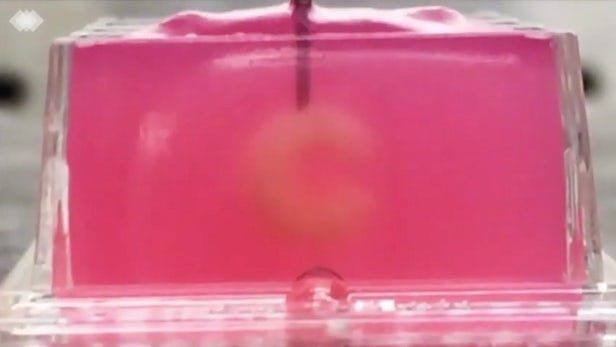
Regenerative medicine technique brings surgeons one step closer to helping patients
A new study by researchers at Children’s Hospital Los Angeles has shown that tissue-engineered small intestine grown from human cells replicates key aspects of a functioning human intestine. The tissue-engineered small intestine they developed contains important elements of the mucosal lining and support structures, including the ability to absorb sugars, and even tiny or ultra-structural components like cellular connections.
Published online January 8 by the American Journal of Physiology: GI & Liver, the work brings surgeons one step closer to helping human patients using this regenerative medicine technique.
Tissue-engineered small intestine (TESI) grows from stem cells contained in the intestine and offers a promising treatment for short bowel syndrome (SBS), a major cause of intestinal failure, particularly in premature babies and newborns with congenital intestinal anomalies. TESI may one day offer a therapeutic alternative to the current standard treatment, which is intestinal transplantation, and could potentially solve its largest challenges – donor shortage and the need for lifelong immunosuppression.
Tracy C. Grikscheit, MD, a principal investigator in The Saban Research Institute of CHLA and its Developmental Biology and Regenerative Medicine program, is also a pediatric surgeon at Children’s Hospital Los Angeles and an assistant professor of surgery at the Keck School of Medicine of the University of Southern California.
Grikscheit aims to help her most vulnerable young patients, including babies who are born prematurely and develop a devastating disease called necrotizing enterocolitis (NEC), where life-threatening intestinal damage requires removal of large portions of the small intestine. Without enough intestinal length, the babies are dependent on intravenous feeding, which is costly and may cause liver damage. NEC and other contributors to intestinal failure occur in 24.5 out of 100,000 live births, and the incidence of SBS is increasing. Nearly a third of patients die within five years.
CHLA scientists had previously shown that TESI could be generated from human small intestine donor tissue implanted into immunocompromised mice. However, in those initial studies – published in July 2011 in the biomedical journal Tissue Engineering, Part A – only basic components of the intestine were identified. For clinical relevance, it remained necessary to more fully investigate intact components of function such as the ability to form a healthy barrier while still absorbing nutrition or specific mechanisms of electrolyte exchange.
The new study determined that mouse TESI is highly similar to the TESI derived from human cells, and that both contain important building blocks such as the stem and progenitor cells that will continue to regenerate the intestine as a living tissue replacement. And these cells are found within the engineered tissue in specific locations and in close proximity to other specialized cells that are known to be necessary in healthy human intestine for a fully functioning organ.
Read more: Researchers Grow Functional Tissue-Engineered Intestine from Human Cells
The Latest on: Regenerative medicine
[google_news title=”” keyword=”Regenerative medicine” num_posts=”10″ blurb_length=”0″ show_thumb=”left”]
via Google News
The Latest on: Regenerative medicine
- New prototype that regenerates stem cells may repair IPF scarringon April 26, 2024 at 10:42 am
Researchers developed NZ-97, an inhalable drug that stimulates the growth of stem cells in the lungs, potentially repairing scarring in IPF.
- Regenerative Medicine Market Size Expected to Reach USD 154.05 Bn by 2033on April 26, 2024 at 8:10 am
The global regenerative medicine market size is expected to reach around USD 154.05 billion by 2033 increasing from USD 29.42 billion in 2023, growing at a healthy CAGR of 18% from 2024 to 2033.Ottawa ...
- ROSM can help reduce pain & enhance mobilityon April 26, 2024 at 2:00 am
Struggling with pain that limits your mobility? ROSM in the D.C., Maryland, and Virginia area offers advanced treatments to help you get back to daily activity!
- Completely New Use Discovered – This Traditional Herb Has Remarkable Nerve Regenerative Propertieson April 25, 2024 at 4:01 pm
Blessed thistle (Cnicus benedictus), a member of the Asteraceae family, thrives in our climate. This plant has been utilized for centuries as a medicinal herb, often consumed as an extract or tea to ...
- Cabinet approves two bills on regenerative medicineon April 25, 2024 at 9:00 am
The draft regenerative medicine bill stipulates that only government-certified medical institutions can administer such treatments, with individuals or organizations that administer them without ...
- Is Telepathy Possible? Perhaps, Due To New Technologyon April 24, 2024 at 11:00 am
Telepathy is generally considered pure science fiction; fun, but never something that will actually happen. But new research suggests we may be closer than we think.
- What Is Drug Repurposing And Why Is It A Game-Changer In Regenerative Medicine?on April 23, 2024 at 7:55 am
Repurposed drugs have already undergone rigorous testing for safety and efficacy in other medical conditions. It enables researchers to fast-track their investigations, saving time and resources.
- How Regenerative Medicine Can prevent Autism Spectrum Disorder, Expert Explainson April 22, 2024 at 11:51 pm
Central to regenerative medicine's approach to treating autism is the rejuvenation of damaged neural networks. Stem cell therapies hold promise for replenishing depleted or dysfunctional neural ...
- Kansas Regenerative Medicine Center celebrates 10 years of transformative healthcareon April 18, 2024 at 11:29 am
Milestone achieved by Kansas Regenerative Medicine Center as the organizations marks 10 years of helping patients.
- Immunotherapy Regenerative Medicine Clinic on Using Stem Cells to Activate the Body's Natural Healing Poweron April 18, 2024 at 10:02 am
Stem cell therapy, a cornerstone of regenerative medicine, has shown immense potential in treating autoimmune diseases, aging conditions, and ...
via Bing News










